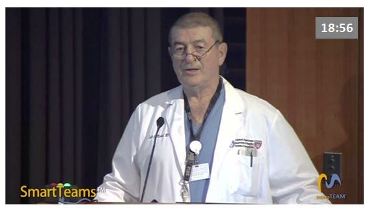
SmartTeams™ Talks - September 2014
On September 15, 2014, MomsTEAM Institute hosted a day-long summit at Harvard Medical School's Joseph B. Martin Center at which many members of our star-studded Board of Advisors, comprised of many of the country's leading clinicians, researchers and youth sports safety advocates, gave educational, "TED-talk"-style presentations on youth sports health and safety best practices.
The summit attracted a group of sports parents, medical doctors, athletic trainers, neuropsychologists, sports psychologists, nurses, athletic directors, sports administrators, coaches, sports equipment and testing manufacturers, students and other youth sports stakeholders, and coincided with the launch of MomsTEAM Institute’s innovative SmartTeam™ program, which tested youth sports health and safety best practices and educational interventions in six pilot programs around the country in the fall of 2014 and in Grand Prairie, Texas in the fall of 2015. Each speaker focused on a specific way youth sports programs can help young athletes play safe by being smart.

SmartTeams™ Talks - August 2015
In August 2015, MomsTEAM Institute Executive Director, Brooke de Lench, returned to Grand Prairie, Texas, one of the six communities participating in the 2014 pilot program, to continue working with administrators, coaches, parents, and athletes in the city's youth tackle and flag football and cheer program as part of MomsTEAM's SmartTeams™/Unicef pilot project.
In addition to furnishing the program with loads of new equipment - much of it donated by MomsTEAM underwriters - de Lench assembled in Grand Prairie another great team of youth sports health and safety experts and safety equipment manufacturers from around the country and the world to give presentations to the Grand Prairie youth football and cheer community and sit down for videotaped interviews.
Together, the SmartTeams™ Talks offer a holistic approach to improving youth sports safety addressing, not just a child’s physical safety, but emotional, psychological and sexual safety, and show how, by following best practices, we can help keep youth athletes safer.
Deron Colby, JD: To an Athlete Dying Young: Why the Time for SmartTeams™ Is Now
Dr. Doug Casa Says Enacting Pro-Active Policies To Prevent Sudden Death In Youth Sports Is Challenging
NCAA's Dr. Brian Hainline Offers Solutions for the Youth Sports Injury Epidemic
Rosalind Wiseman Offers Parents and Coaches Ways To Use Sports To Teach Important Life Lessons
Law Professor Doug Abrams Urges Using Power of Permit To Improve Youth Sports Safety
Dr. Jim MacDonald Urges Multi-Pronged Public Health Approach To Preventing Youth Sports Injuries
Dr. Neeru Jayanthi's Message To Youth Sports Parents Is To "Let Kids Be Kids"
Sports Dietitian Allison Maurer Says Youth Athletes Grossly Overfed But Chronically Under-Fueled
Joe Ehrmann Urges Coaches To Reclaim Sport's Educational, Social, and Ethical Role In Society
Dr. Rosemarie Moser Says Her Research And Clinical Experience Show That Cognitive Rest Really Is The Best Treatment For Concussion
Father of Modern Sports Medicine, Dr. Lyle Micheli, Urges Youth Sports Injury Prevention Focus
Dr. Tracey Covassin Explains The Role of Gender In Concussion Risk and Outcomes
Dr. Tamara Valovich McLeod Introduces SmartTeams Program Designed To Implement Best Youth Sports Health and Safety Practices
Pilot Coordinators Discuss SmartTeams Program


















